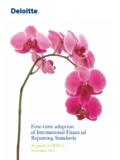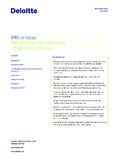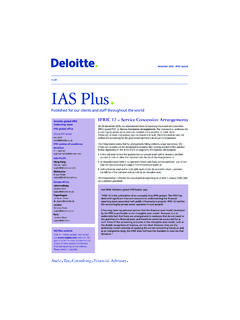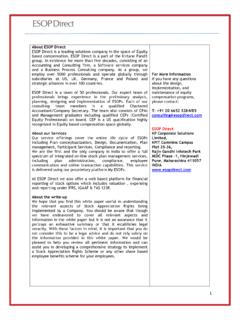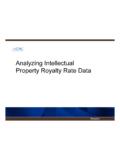Transcription of IAS Plus
1 Amendments to IAS 39 & IFRS 7 reclassification of financial assets (updated)On 13 October 2008, the International accounting Standards Board (IASB) publishedamendments to IAS 39 Financial Instruments: Recognition and Measurementand IFRS 7 Financial Instruments: amendments are a response to calls from constituents, particularly within the EuropeanUnion, to create a level playing field with US GAAP regarding the ability to reclassify financialassets. The changes to IAS 39 permit an entity to reclassify non-derivative financial assetsoutof the fair value through profit or loss (FVTPL) and available-for-sale (AFS) categoriesin limited circumstances. Such reclassifications will trigger additional disclosure 24 October 2008, in response to queries raised by practitioners, the IASB issued clarifyingguidance in its October Update regarding the effective date of the amendments andtransitional provisions.
2 This newsletter has been updated to reflect that supplementaryguidance (see page 3).Scope of the amendmentsThe amendments will only permit reclassification of certain non-derivative financial assetsrecognised in accordance with IAS 39. Financial liabilities, derivatives and financial assetsthat are designated as at FVTPL on initial recognition under the fair value option cannot bereclassified. The amendments therefore only permit reclassification of debt and equityfinancial assets subject to meeting specified amendments do not permit reclassification out of FVTPL and AFSA financial asset within the scope of these amendments can only be reclassified out of FVTPLor AFS if specified criteria are met. The criteria vary depending on whether the asset wouldhave met the definition of loans and receivables (L&R) had it not been classified as at FVTPLor AFS at initial debt instrument that would have met the definition of L&R (if it had not been required tobe classified as held for trading at initial recognition) may be reclassified out of FVTPL if theentity has the intention and ability to hold the asset for the foreseeable future or for our clients and staff throughout the worldOctober 2008 Special editionIAS Plus websiteOver 7 million people have visited our site.
3 Our goal is to bethe most comprehensive source of news about international financial reporting on theInternet. Please check in global IFRS leadership teamIFRS global officeGlobal IFRS leaderKen centres of excellenceAmericasNew YorkRobert KongStephen Peter bd IAS39-IFRS7:27041 IAS39-IFRS7 bd 29/10/08 12:49 Page 1A debt instrument classified as AFS that would have met the definition of L&R (if it had notbeen designated as AFS) may be reclassified to the L&R category if the entity has theintention and ability to hold the financial asset for the foreseeable future or until other debt instrument, or any equity instrument, may be reclassified from FVTPL to AFS,or from FVTPL to HTM (in the case of debt instruments only), if the financial asset is nolonger held for the purpose of selling in the near term but only in rare circumstances.
4 In its press release the IASB acknowledged that market conditions in the third quarter of2008 are a possible example of a rare should be noted that the amendments do not refer to the reclassification of AFS debtinstruments to HTM because IAS 39 already permitted such reclassifications (see IAS ).These reclassifications are not within the scope of the current amendments, and thereforethey do not trigger the additional disclosures required by IFRS referred to at the reclassification dateAll reclassifications must be made at the fair value of the financial asset at the date ofreclassification. Any previously recognised gains or losses cannot be reversed. The fair valueat the date of reclassification becomes the new cost or amortised cost of the financial asset,as after the reclassification dateThe existing requirements in IAS 39 for measuring financial assets at cost or amortised costapply after the reclassification date (with one exception see below).
5 Therefore, for financialassets measured at amortised cost, a new effective interest rate will be determined at thedate of reclassification. In the case of reclassifications of a fixed rate debt instrument to L&Rand HTM, this effective interest rate will be used as the discount rate for future reclassifications out of AFS, IAS requires the amounts previously recognised inother comprehensive income (OCI) to be reclassified to profit or loss either through theeffective interest rate (if the instrument has a maturity) or at disposal (if the instrument hasno maturity it is perpetual). Amounts deferred in equity may also need to bereclassified to profit or loss if there is an one exception to the existing measurement requirements is for reclassified debtinstruments.
6 If, after reclassification, an entity increases its estimate of recoverability offuture cash flows, the carrying amount is not adjusted upwards as is currently required byIAS for changes in estimates of cash flows. Instead, a new effective interest rate isdetermined and is applied from that date forward. Hence, the increase in the recoverabilityof cash flows is recognised over the expected life of the financial make transparent to users any reclassifications under the new requirements, IFRS 7 is alsoamended. Although the requirements for reclassifications in accordance with IAS unchanged (IFRS ), the following additional disclosures are required forreclassifications within the scope of the current amendments (new paragraph IFRS ): the amount reclassified into and out of each category; for each reporting period until derecognition, the carrying amounts and fair values of allfinancial assets reclassified in the current or previous reporting periods; if the financial asset has been reclassified based on the rare circumstances exception,details of those circumstances including the factors that indicated that the situationwas rare.
7 The fair value gain or loss recognised in profit or loss or OCI for the reporting period inwhich reclassification occurs and in the previous period; in the period of reclassification and in subsequent periods until the financial asset isderecognised, the gain or loss that would have been recognised in profit or loss or OCIhad the financial asset not been reclassified, and the actual gain, loss, income andexpense recognised in profit or loss; and the effective interest rate and estimated cash flows the entity expects to recover as atthe date of reclassification of the financial Plus October 2008 Special edition227041 bd IAS39-IFRS7:27041 IAS39-IFRS7 bd 29/10/08 12:49 Page 2 Effective date and transitionThese amendments are effective from 1 July 2008.
8 Entities are not permitted to reclassifyfinancial assets in accordance with the amendments before 1 July 2008. The amendmentsstate that any reclassification of a financial asset made in periods beginning on or after1 November 2008 will take effect only from the date when the reclassification is made. Any reclassification of a financial asset in accordance with the amendments should not beapplied retrospectively to reporting periods ended before the effective IASB has clarified the following points. For reclassifications made before 1 November 2008, an entity can reclassify a financialasset with effect from 1 July 2008 (but not before), or any date thereafter until31 October 2008. Such assets must be identified and documented before 1 November2008. For example, an entity with an October year end may wish to choose 1 August as thedate of reclassification, rather than 1 July, in order for the reclassifications to take effectat the start of Q4, rather than part way through Q3.
9 Equally, an entity s intent to hold for trading purposes may have changed part-waythrough a period for different loans, say 5 September, 25 September etc, as a result ofspecific events on those dates. An entity could reclassify at various dates if the criteriaare met and evidence is available regarding the change of intent. Any reclassification made on or after 1 November 2008 (irrespective of when theaccounting period started) is effective from the date of reclassification are made on a real-time example, an entity with a Q4 ending 31 December can make reclassifications on orafter 1 November and they will take effect from the dates the assets are Plus October 2008 Special editionFor more information on Deloitte Touche Tohmatsu, please access our website at provides audit, tax, consulting, and financial advisory services to public and private clients spanning multipleindustries.
10 With a globally connected network of member firms in 140 countries, Deloitte brings world-class capabilitiesand deep local expertise to help clients succeed wherever they operate. Deloitte s 150,000 professionals are committedto becoming the standard of excellence. Deloitte s professionals are unified by a collaborative culture that fosters integrity, outstanding value to markets andclients, commitment to each other, and strength from cultural diversity. They enjoy an environment of continuouslearning, challenging experiences, and enriching career opportunities. Deloitte s professionals are dedicated tostrengthening corporate responsibility, building public trust, and making a positive impact in their communities. Deloitte refers to one or more of Deloitte Touche Tohmatsu, a Swiss Verein, and its network of member firms, each ofwhich is a legally separate and independent entity.
